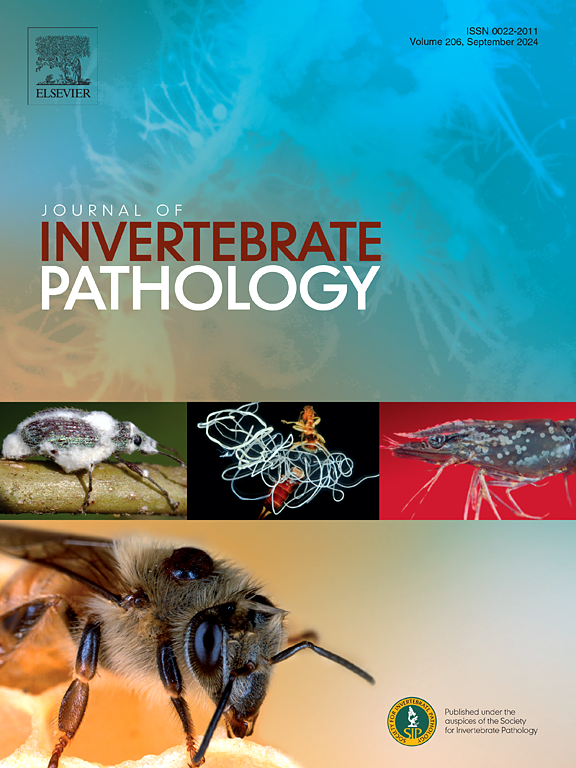球孢白僵菌对家蚕免疫反应的影响:血细胞动力学的研究。
IF 2.4
3区 生物学
Q1 ZOOLOGY
引用次数: 0
摘要
昆虫的免疫反应对于抵御外来病原体的侵袭至关重要。本研究探讨了昆虫病原真菌与昆虫免疫反应之间的相互作用,特别是球孢白僵菌对家蚕循环血细胞的影响。利用血细胞计数、电子显微镜和台盼蓝染色,我们评估了总血细胞计数以及粒细胞(GR)和浆细胞(PL)。与对照组相比,所有处理组的家蚕循环血细胞总数均显著减少(P 5、1 × 106和1 × 107孢子/mL)。值得注意的是,1 × 107 孢子/mL处理导致感染后3 h血细胞数量显著减少,表明细胞免疫反应强劲。在最高浓度组,GR计数最初增加,但在处理后3 h显著下降,可能是由于它们在免疫活性增强期间快速消耗。相比之下,PL计数在处理后0 h显著下降,并继续下降,在6 h达到最小值。扫描电镜和透射电镜显示血细胞形态学改变,包括膜损伤和细胞质渗漏,这与观察到的细胞活力下降有关。1 × 107 孢子/mL组的血细胞存活率显著下降,在处理后36 h达到21.24 %的低水平。此外,在高浓度治疗中,观察到结节形成增加,在感染后6 h达到峰值,表明积极的免疫反应。这些发现说明了球孢白僵菌对家蚕血细胞的致病作用,增强了我们对真菌感染免疫动力学的理解,为昆虫病原真菌在害虫生物防治策略中的潜在应用提供了见解。本文章由计算机程序翻译,如有差异,请以英文原文为准。

Effects of Beauveria bassiana on immune responses in the silkworm, Bombyx mori: focus on haemocyte dynamics
The immune responses of insects are crucial for their defense against invasive foreign pathogens. This study investigates the interactions between entomopathogenic fungi and insect immune responses, specifically examining the effects of Beauveria bassiana on the circulating blood cells of silkworms (Bombyx mori). Utilizing haemocytometry, electron microscopy, and trypan blue staining, we assessed total blood cell counts along with granulocytes (GR) and plasmatocytes (PL). Significant reductions in total circulating blood cells of silkworms were observed across all treatment groups compared to the control (P < 0.05) at concentrations of 1 × 105, 1 × 106, and 1 × 107 spores/mL. Notably, the 1 × 107 spores/mL treatment resulted in a marked decrease in blood cell numbers at 3 h post-infection, indicating a robust cellular immune response. The GR count initially increased but decreased significantly at 3 h post-treatment in the highest concentration group, likely due to their rapid consumption during heightened immune activity. In contrast, the PL count decreased significantly at 0 h post-treatment and continued to decrease, reaching a minimum at 6 h. Scanning and transmission electron microscopy revealed morphological alterations in blood cells, including membrane damage and cytoplasmic leakage, which correlated with the observed declines in cell viability. The survival rate of blood cells significantly decreased, reaching a low of 21.24 % at 36 h post-treatment in the 1 × 107 spores/mL group. Additionally, an increase in nodule formation was observed, peaking at 6 h post-infection in the high-concentration treatment, indicating an active immune response. These findings illustrate the pathogenic effects of B. bassiana on silkworm blood cells and enhance our understanding of immune system dynamics in response to fungal infection, providing insights into the potential applications of entomopathogenic fungi for biological control strategies in pest management.
求助全文
通过发布文献求助,成功后即可免费获取论文全文。
去求助
来源期刊
CiteScore
6.10
自引率
5.90%
发文量
94
审稿时长
1 months
期刊介绍:
The Journal of Invertebrate Pathology presents original research articles and notes on the induction and pathogenesis of diseases of invertebrates, including the suppression of diseases in beneficial species, and the use of diseases in controlling undesirable species. In addition, the journal publishes the results of physiological, morphological, genetic, immunological and ecological studies as related to the etiologic agents of diseases of invertebrates.
The Journal of Invertebrate Pathology is the adopted journal of the Society for Invertebrate Pathology, and is available to SIP members at a special reduced price.

 求助内容:
求助内容: 应助结果提醒方式:
应助结果提醒方式:


